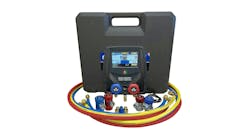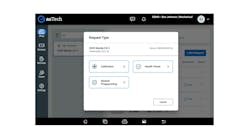Tool reviewer Randy Kaiser likes everything the Cal-Van C-Frame Socket Press has to offer: its strength, the fact he can use sockets he already owns, and the (included) adapters that hold the sockets in place to keep them from falling to the floor.
Kaiser is a service manager and partial owner at Rost Motor, Inc. in Manson, Iowa. He says the tool is very easy to use and the idea behind it is “ingenious.”
“We’ve probably all drug the driveshaft to the bench vise, found the right size sockets, and used the vise to push the U-joint out and a new one in,” Kaiser says. “This [C-Frame Socket Press] has adapters that hold the sockets in place so that they don’t fall on the floor every time something shifts. You can line everything up, hit it with the impact wrench, and problem solved.”
The tool saves the technician time in a few different ways. It is designed to use sockets – sockets the technicians already owns – as the forcing and receiving portion of the tool. Since virtually everyone has sockets readily available, this saves time looking for the correct forcing cone, Kaiser says.
The socket press is also portable – another notable feature that can save a technician time. The press can be taken over to the vehicle instead of bringing the part needing repair to the tool, depending on the type of repair.
When the tool arrived, it came packaged in a plastic case with dividers for each adapter, along with a separate area for the C-frame press. Kaiser notes the case is convenient to have and makes it easy to carry everything (the tool and adapters) to the vehicle. The unit also came with all the necessary adapters for 1/4”, 3/8”, and 1/2” sockets, as well as two flat pushing adapters.
“The only setup is to find the correct adapter in the tool set for the socket that you want to use, insert it into the tool, slip the socket onto the adapter, and you’re ready to go,” he adds.
When using the tool, Kaiser says to simply install the correct adapter and socket, line it up with your job, and tighten the forcing screw to apply pressure.
In the shop, Kaiser used the press to remove and replace universal joints in driveshafts.
“It looks like it would also work extremely well for replacing bushings, but I haven’t had the opportunity to use it for that yet,” Kaiser says.
Kaiser admits that initially, he had concerns regarding the tool’s strength and robustness. However, with its rating of 2.5 tons, the tool has held up just fine so far, he says. He notes that it would be helpful to have a larger C-frame available that also uses the same adapters for times when more capacity is needed.
Overall, Kaiser enjoyed the Cal-Van C-Frame Socket Press, especially as it uses sockets that technicians already own, and there is no need to buy more forcing cones of various sizes.




